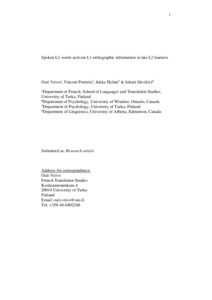Spoken second language words activate native language orthographic information in late second language learners
Outi Veivo; Vincent Porretta; Jukka Hyönä; Juhani Järvikivi
https://urn.fi/URN:NBN:fi-fe2021042719376
Tiivistelmä
This study investigated the time course of activation of orthographic
information in spoken word recognition with two visual world
eye-tracking experiments in a task where second language (L2) spoken
word forms had to be matched with their printed referents. Participants (n
= 64) were native Finnish learners of L2 French ranging from beginners
to highly proficient. In Experiment 1, L2 targets (e.g., /sidʀ/) were presented with either orthographically overlapping onset competitors (e.g., /sɛ̃tʀ/) or phonologically overlapping onset competitors ( /sikl/). In Experiment 2, L2 targets (e.g., /pom/) were associated with competitors in Finnish, L1 of the participants, in conditions symmetric to Experiment 1 ( /pauhu/ vs.
/pom:i/). In the within-language experiment (Experiment 1), the
difference in target identification between the experimental conditions
was not significant. In the between-language experiment (Experiment 2),
orthographic information impacted the mapping more in lower proficiency
learners, and this effect was observed 600 ms after the target word
onset. The influence of proficiency on the matching was nonlinear:
proficiency impacted the mapping significantly more in the lower half of
the proficiency scale in both experiments. These results are discussed
in terms of coactivation of orthographic and phonological information in
L2 spoken word recognition.
Kokoelmat
- Rinnakkaistallenteet [27094]
